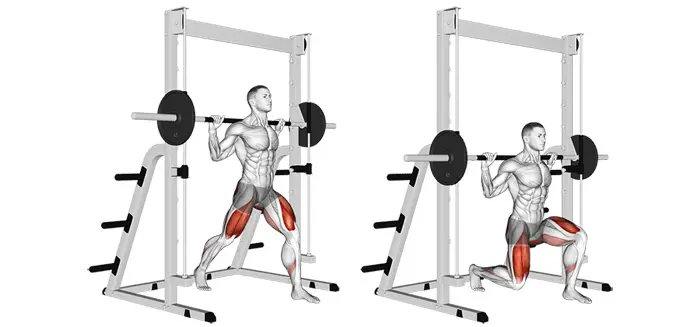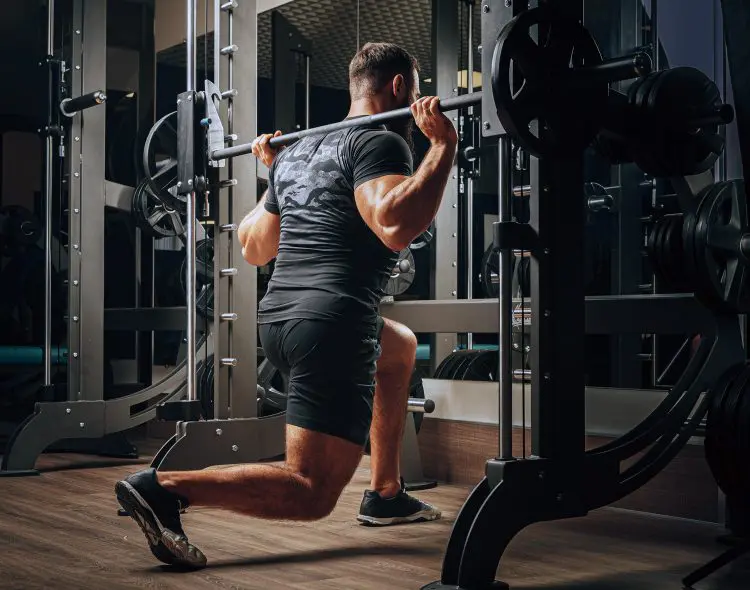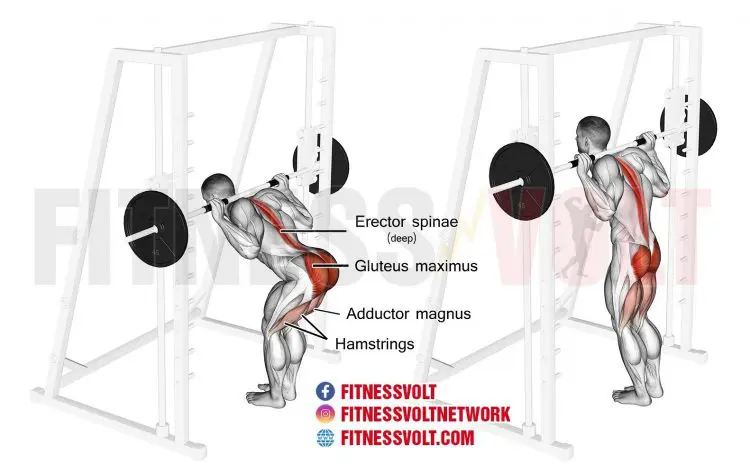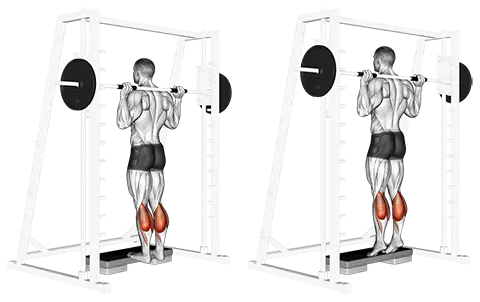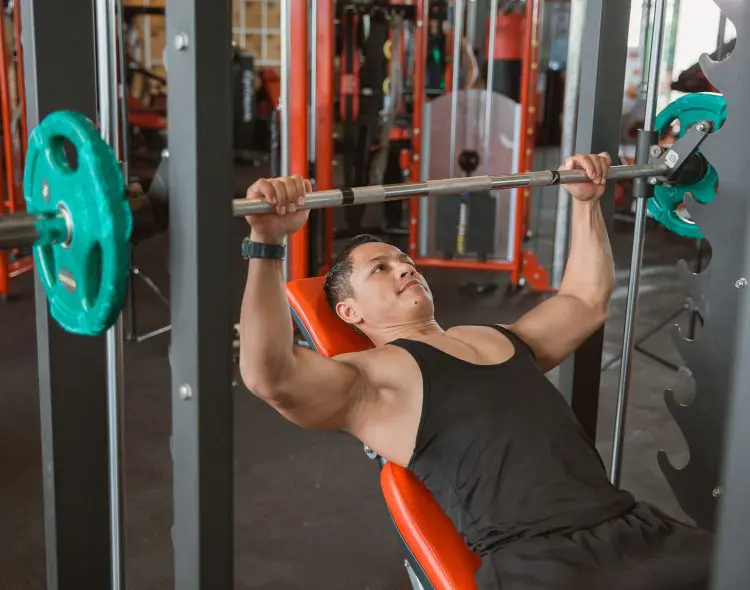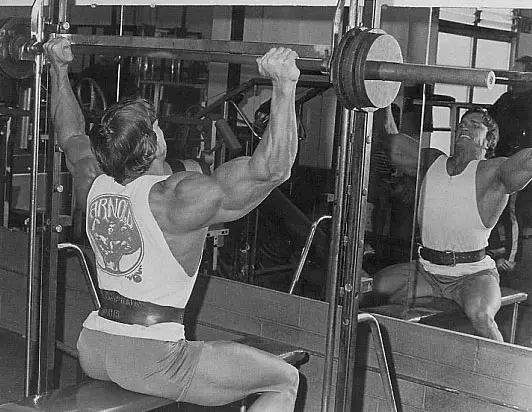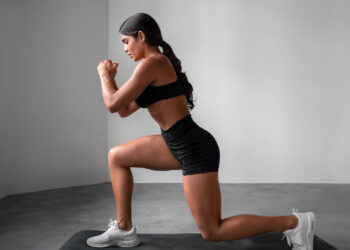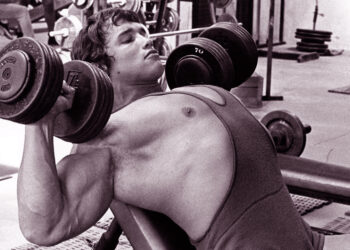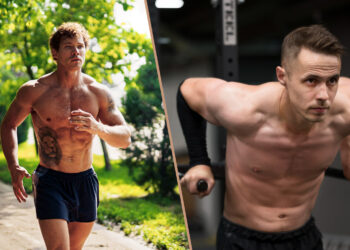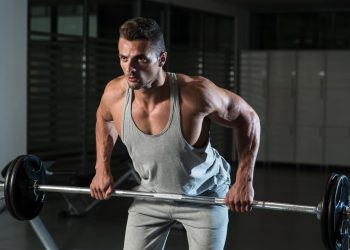The Smith machine is arguably the most controversial workout machine. It’s often said that it’s not functional or that using one increases injury risk. Some even say that squats and bench presses done with the Smith machine aren’t real lifts and that, in some way, they are a form of cheating.
The reality is that the Smith machine is just another training tool that you can choose to use or ignore according to your workout preferences and goals.
For example, if you are a powerlifter, Smith machine squats are of limited benefit as you’ll be using a free-weight barbell in competition. However, if you are a bodybuilder, using a Smith machine allows you to position your feet to emphasize specific muscle groups.
The truth is that people much bigger and stronger than you have successfully used the Smith machine, and dismissing it is a mistake. I’m not saying you have to use one if you don’t want to, but there may be times when training with a Smith machine may be beneficial.
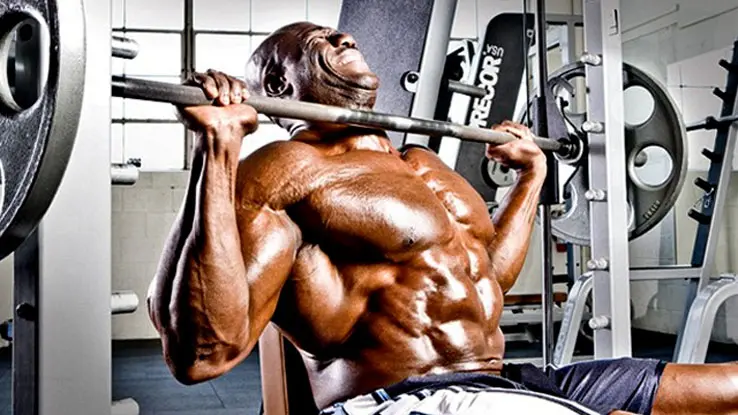
Like barbells, dumbbells, kettlebells, and every other type of training equipment, Smith machines are just tools. They aren’t good or bad – they just are!
Level Up Your Fitness: Join our 💪 strong community in Fitness Volt Newsletter. Get daily inspiration, expert-backed workouts, nutrition tips, the latest in strength sports, and the support you need to reach your goals. Subscribe for free!
As a veteran personal trainer with over 35 years of experience, I’ve helped several people transform their physiques with nothing more than a Smith machine. In this article, I reveal the 15 most effective Smith machine exercises you can add to your arsenal.
Recent Updates: On July 15, 2024, Fitness Volt’s Senior Editor Vidur Saini (American Council on Exercise-CPT) updated the article and added actionable expert tips throughout the piece to improve the reader experience.
15 Best Smith Machine Exercises
Add the following exercises to your arsenal:
- Front And Back Squats
- Split Squats
- Reverse Lunges
- Good Mornings
- Romanian Deadlift
- Calf Raise
- Bent-Over Row
- Inverted Row
- Shrugs
- Bench Press
- Reverse Grip Bench Press
- Kaz Press
- Overhead Press
- Push-Up Ladder
- Drag Curls
1. Front and Back Squats
| Sets & Reps | 3-4 x 6-8 (strength) or 3-4 x 8-12 (hypertrophy) |
| Equipment Needed | Smith machine |
| Target Muscles | Quadriceps (primary), hamstrings, glutes, adductors, erector spinae (core) |

Squats are the king of lower body exercises. Working your quads, hamstrings, glutes, abductors, and adductors, as well as your core and several upper body muscles, the squat is an essential exercise for most training goals.
Smith machine squats eliminate the need to balance the weight, leaving you free to focus on pumping out the reps. You can also move your feet to target different leg muscles. Place your feet in front of you to emphasize your glutes and hamstrings, or position your feet directly below your hips to hit your quads harder.
“Don’t be afraid to experiment with different squat stances (wide, narrow) to find what works best for your body and goals,” says Saini.
You can do front squats and back squats using a Smith machine.
Pro Tip: Drive your elbows forward aggressively at the bottom of a front squat to maintain an upright torso and prevent the bar from rolling forward.
Check out this guide to learn how to do Smith machine back squats.
| Difficulty | Beginner |
| Progression | Increase weight, pause squats, tempo squats |
| Regression | Box squats, wall sits |
2. Split Squats
| Sets & Reps | 3-4 x 8-12 per leg |
| Equipment Needed | Smith machine |
| Target Muscles | Quadriceps (primary), glutes, hamstrings |
Split squats allow you to emphasize one leg at a time. With split squats, your front leg does more work than your back leg. Smith machine squats make balancing easier, so you can focus entirely on working your muscles as hard as possible.
Saini advises thinking of the back leg as a kickstand for balance and focusing on driving up through the front foot’s heel.
You can do regular split squats or elevate your rear foot and do Bulgarian split squats. They’re both effective Smith machine leg exercises.
Pro Tip: During the eccentric (lowering) phase, focus on maximizing the stretch in the front leg’s glute and quad to enhance activation and mobility.
| Difficulty | Beginner |
| Progression | Bulgarian split squats, deficit split squats |
| Regression | Shorter range of motion, static lunges |
[Related: Check out this in-depth guide to split squats.]
3. Reverse Lunges
| Sets & Reps | 3-4 x 8-12 per leg |
| Equipment Needed | Smith machine |
| Target Muscles | Quadriceps (primary), glutes, hamstrings |
Lunges are one of the best lower body exercises you can do. With lunges, you get to work one leg at a time, which is a handy way to spot left-to-right strength imbalances. There are lots of different lunges to choose from, including forward, lateral, and walking. Check out our detailed guide to lunges to learn more.
Smith machine reverse lunges are an especially useful exercise. Like all lunges, they work your quads, but this variation is really good for your glutes and hamstrings, and it’s not too hard on your knees, either.
Saini suggests keeping your torso upright and core engaged to prevent leaning forward, which can strain your lower back.
Pro Tip: To increase glute activation, actively ‘screw’ your front foot into the floor as you drive back up to the starting position.
| Difficulty | Beginner |
| Progression | Deficit reverse lunges, walking lunges |
| Regression | Stationary lunges, shorter range of motion |
4. Good Mornings
| Sets & Reps | 3 x 8-12 |
| Equipment Needed | Smith machine |
| Target Muscles | Hamstrings (primary), glutes, erector spinae |
Good mornings are a powerful posterior chain exercise. Powerlifters do them as an accessory exercise, and they’re useful for building bigger glutes, hamstrings, and lower back muscles.
While good mornings are commonly performed using a barbell or safety squat bar, they can also be done using a Smith machine. Using a Smith machine forces you to push your hips back more, which increases glute and hamstring activation.
Saini recommends starting with a very light weight and gradually increasing the load as you master the form to protect your lower back.
Pro Tip: Imagine pushing your hips back into a wall behind you while keeping your spine neutral to protect your lower back and maximize hamstring engagement.
| Difficulty | Intermediate |
| Progression | Single-leg good mornings, use bands for resistance |
| Regression | Bodyweight good mornings, assisted good mornings (with a band) |
[Related: Learn how to do this variation here.]
5. Romanian Deadlift
| Sets & Reps | 3-4 x 6-8 (strength) or 3-4 x 8-12 (hypertrophy) |
| Equipment Needed | Smith machine |
| Target Muscles | Hamstrings (primary), glutes, erector spinae |
Romanian deadlifts are another posterior chain exercise that is usually done using a barbell, although it can be done with dumbbells too. But, for variation, why not give Smith machine Romanian deadlifts a try?
With this option, you really have to push your hips back, which increases glute and hamstring recruitment, potentially delivering a better muscle-building workout. Also, as balance is less of an issue when you work out with a Smith machine, you can do single-leg Romanian deadlifts.
Maintain a slight bend in your knees throughout the movement and hinge at the hips rather than rounding your back, says Saini.
Pro Tip: Actively push your hips forward at the top of the movement to fully contract your glutes and hamstrings.
| Difficulty | Intermediate |
| Progression | Deficit RDLs, single-leg RDLs |
| Regression | RDLs with lighter weights, hip hinges, glute bridges |
6. Calf Raise
| Sets & Reps | 3-4 x 15-20 |
| Equipment Needed | Smith machine, aerobic stepper |
| Target Muscles | Gastrocnemius, soleus |
Most gyms have standing calf raises, but it’s always useful to have an alternative in case the machine you want to use is busy or out of order.
You can do calf raises on a leg press, but they’re not especially comfortable and can be dangerous if your feet slip off the footplate. Smith machine calf raises are a better choice for most lifters.
Saini highlights the importance of ensuring the foot platform is sturdy. Keep a weight plate on the opposite end, if necessary.
How to do it:
- Set the bar on your Smith machine to just above shoulder-height. Place a 4-6” block or a couple of weight plates on the floor directly beneath the bar.
- Place the balls of your feet on the raised platform, duck under the bar, and rest it across the fleshy part of your upper back and not on your neck. Brace your abs and extend your legs. This is your starting position.
- Without bending your legs, lower your heels down toward the floor and then push up onto your tiptoes.
Pro Tip: For greater time under tension and hypertrophy, pause for a full second at the peak contraction (top of the movement) and slowly lower your heels.
| Difficulty | Beginner |
| Progression | Single-leg calf raises, tempo calf raises |
| Regression | Bodyweight calf raises, seated calf raises |
7. Bent-Over Row
| Sets & Reps | 3-4 x 6-8 (strength) or 3-4 x 8-12 (hypertrophy) |
| Equipment Needed | Smith machine |
| Target Muscles | Lats (primary), rhomboids, traps, rear deltoids, biceps |
The bent-over row is a superb back builder. There are several equally effective variations for you to choose from, including overhand rows, underhand rows, Yate’s rows, and Pendlay rows. Now you can add Smith machine rows to your list of back exercises.
In fact, you can perform almost any kind of barbell row using a Smith machine. Some exercisers find that Smith machine rows are easier on their lower backs than the barbell version. Try them for yourself and see!
Saini advises keeping your back flat and neck neutral throughout the exercise for maximal muscle stimulation.
Pro Tip: As you pull the bar towards your body, think about initiating the movement by retracting your shoulder blades (squeezing them together) before bending your elbows.
| Difficulty | Beginner |
| Progression | Pendlay rows, single-arm dumbbell rows |
| Regression | Inverted rows, TRX rows, seated rows with lighter weights |
[Related: Learn how to do Smith machine bent-over Yate’s rows in this handy guide.]
8. Inverted Row
| Sets & Reps | 3-4 x as many reps as possible (AMRAP) |
| Equipment Needed | Smith machine |
| Target Muscles | Lats (primary), rhomboids, traps, rear deltoids, biceps |
Inverted rows are another excellent compound back exercise. While you can do this move using a TRX, gymnastic rings, or a barbell in a squat rack, one of the most convenient places to do it is with a Smith machine.
You can adjust the height of the bar precisely and may be able to brace your feet against the frame for greater comfort and stability.
Engage your core and glutes to maintain a straight line from head to heels, preventing sagging in the middle, Saini says.
Pro Tip: To increase lat engagement, visualize pulling your elbows down and back towards your hips rather than simply pulling your chest to the bar.
| Difficulty | Beginner |
| Progression | Elevate feet, use weighted vest, single-arm variations |
| Regression | Adjust body angle to make it easier, use assistance bands |
[Related: Find out how to do inverted rows here.]
Level Up Your Fitness: Join our 💪 strong community in Fitness Volt Newsletter. Get daily inspiration, expert-backed workouts, nutrition tips, the latest in strength sports, and the support you need to reach your goals. Subscribe for free!
9. Shrugs
| Sets & Reps | 3-4 x 8-12 |
| Equipment Needed | Smith machine |
| Target Muscles | Upper trapezius, levator scapulae |
If you want mountainous traps, shrugs are a must. You can do shrugs with a barbell, dumbbells, or a trap bar, and also in front or behind your legs. You can also do hands-free shrugs using a standing calf-raise machine.
For variation, why not try doing barbell shrugs on the Smith machine? They force you to focus on the elevation of your shoulder girdle, which is the primary function of the upper traps. You can do Smith machine shrugs with the bar in front of you or behind as preferred.
“Think about lifting your ears to the ceiling to fully activate your upper traps and avoid excessive shoulder rotation,” Saini cues.
Pro Tip: For maximum trapezius activation, incorporate a slight upward rotation of your shoulder blades as you shrug to engage the upper fibers fully.
| Difficulty | Beginner |
| Progression | Dumbbell shrugs, trap bar shrugs |
| Regression | Scapular wall slides, light shrugs |
10. Bench Press
| Sets & Reps | 3-4 x 6-8 (strength) or 3-4 x 8-12 (hypertrophy) |
| Equipment Needed | Smith machine |
| Target Muscles | Pectoralis major (primary), anterior deltoids, triceps |
Purists may scoff at the idea of doing Smith machine bench presses, but with no balance to worry about, you’re free to focus on pumping out the reps and pushing your pecs to their limit. You can do flat, incline, decline bench, and close-grip bench presses on the Smith machine, and also do floor presses.
The most important thing to consider with any kind of Smith machine bench press is where you position your bench.
If it’s too far forward, you’ll end up lowering your bar to your neck. While neck presses ARE a legitimate exercise, they can be hard on your shoulders. Conversely, if you place the bench too far back, you’ll end up lowering the bar down toward your abdomen, again risking the health of your shoulders.
Do a few reps with the empty bar to make sure you’ve got the bench in the right place – neither too far forward nor backward. The bar should touch your sternum at the bottom of each rep.
Saini recommends tucking your elbows slightly in towards your body (about a 45-degree angle) to protect your shoulder joints and maximize chest activation.
Pro Tip: Focus on pushing yourself away from the bar rather than pushing the bar away from you to engage your lats and create a stable base for the press
| Difficulty | Beginner |
| Progression | Incline or decline variations, pause reps |
| Regression | Dumbbell bench press, push-ups, incline dumbbell press |
11. Reverse-Grip Bench Press
| Sets & Reps | 3-4 x 6-8 (strength) or 3-4 x 8-12 (hypertrophy) |
| Equipment Needed | Smith machine |
| Target Muscles | Pectoralis major (upper emphasis), anterior deltoids, triceps |
The reverse grip bench press is an old-school chest exercise that targets your upper pecs. While it’s usually done with a barbell, this is neither comfortable nor especially safe as the bar could easily slip or roll out of your hands.
Using a Smith machine makes this unusual exercise much less risky and, providing you remember to set the safety catches, you don’t need a spotter to do it. Liven up your chest workouts with reverse grip smith machine bench presses. They can be done on a flat, incline, or decline bench as preferred.
Focus on squeezing your shoulder blades together and keeping your wrists straight to avoid discomfort, recommends Saini.
Pro Tip: Beginners should master the dumbbell variation of this exercise before moving to the barbell.
| Difficulty | Intermediate |
| Progression | Close-grip variations, pause reps |
| Regression | Dumbbell reverse grip press, close-grip push-ups |
12. Kaz Press
| Sets & Reps | 3-4 x 8-12 |
| Equipment Needed | Smith machine |
| Target Muscles | Pectoralis major (upper emphasis), anterior deltoids, triceps |
The Kaz press is named after the famous World’s Strongest Man winner, Bill Kazmaier, who once held the bench press world record at 661 pounds.
The Kaz press is a cross between the close-grip bench press and skull crushers. He used this movement to increase triceps strength for his record-breaking bench press. The Kaz press also works your chest, but it’s quite normal to mainly feel it in the triceps.
Lower the barbell slowly and under control, focusing on the stretch in your chest at the bottom of the movement,” says Saini.
How to do it:
- Lie on a flat bench beneath the barbell. Grab the bar with a shoulder-width or slightly narrower overhand grip. The bar should be directly above your shoulders. Unrack the bar.
- Bend your arms and push your elbows forward as you lower the bar toward your chest.
- Stop with the bar about three inches off your chest, and then push it back up to the starting position.
Pro Tip: As you press the barbell up, think about rotating your palms inward (towards each other) to target the upper chest fibers better.
| Difficulty | Intermediate |
| Progression | Incline or decline variations |
| Regression | Seated dumbbell press, incline dumbbell press |
13. Overhead Press
| Sets & Reps | 3-4 x 6-8 (strength) or 3-4 x 8-12 (hypertrophy) |
| Equipment Needed | Smith machine |
| Target Muscles | Anterior deltoids (primary), triceps, upper trapezius |
If you want to develop big, powerful shoulders, overhead presses are a must. You can do overhead presses with a barbell or dumbbells, and seated or standing; they’re all great shoulder builders.
Smith machine overhead presses provide you with another shoulder pressing option. The main advantage of this exercise that you’re free to focus on lifting and lowering the weight and don’t need to worry about balance.
You can do Smith machine overhead presses to the front or the back of your neck, but behind the neck presses put extra stress on your shoulder joints. Depending on the height of your Smith machine, you may have to do this exercise seated and not standing.
Saini advises keeping your head neutral and avoiding leaning back excessively to maintain proper spinal alignment and prevent injury at the top of the press.
Pro Tip: Brace your core and slightly tuck your chin before pressing the weight up to create a stable base and protect your spine.
| Difficulty | Beginner |
| Progression | Single-arm overhead press, push press |
| Regression | Seated dumbbell shoulder press, push press with lighter weight |
14. Push-Up Ladder
| Sets & Reps | 3-4 sets (increasing reps each set) |
| Equipment Needed | Smith machine |
| Target Muscles | Pectoralis major, anterior deltoids, triceps |
Push-ups are a criminally underrated upper-body exercise. They work your chest, shoulders, and triceps, and your core and legs get in on the workout too.
You can use a Smith machine for push-ups and extend your set well beyond failure with a mechanical drop set. This will really pump up your pecs and provides an excellent finish to any chest workout.
Saini advises against sacrificing form for reps. If you start to get sloppy, rest briefly before continuing to the next set.
How to do it:
- Set the bar on your Smith machine to the lowest level. Using a shoulder-width grip on the bar, adopt the push-up position. Brace your abs and make sure your body is straight. Pump out as many reps as you can.
- Move the bar up by one height increment, get back into the push-up position, and rep out again.
- Raise the bar again and repeat.
- Continue raising the bar and repping out until you cannot continue or are more or less upright.
Pro Tip: To maximize muscle activation and avoid plateaus, vary hand positions (wide, close, staggered) throughout your sets
| Difficulty | Beginner |
| Progression | Add weight (vest or plate), try harder variations |
| Regression | Knee push-ups, incline push-ups, wall push-ups |
15. Drag Curls
| Sets & Reps | 3-4 x 8-12 |
| Equipment Needed | Smith machine |
| Target Muscles | Biceps brachii (long head emphasis) |
Biceps exercises don’t come much more unusual than Smith machine drag curls. This exercise all-but eliminates momentum to create a very strict biceps workout.
This is a tough exercise, so you won’t need much weight. In fact, if you’ve already worked your biceps with other types of curls, the empty Smith machine bar may be sufficient.
Saini recommends keeping the bar close to your body throughout the movement and focusing on driving your elbows back to maximize biceps activation.
How to do it:
- Set the Smith machine bar to a little below hip-height. Hold the bar using an underhand, shoulder-width grip.
- Bend your arms, pull your elbows backward, and drag the bar up the front of your body. Curl the bar as high as you can without leaning away from the bar.
- Lower the bar back down and repeat.
Pro Tip: As you drag the bar up your thighs, focus on driving your elbows as far back as possible to enhance the stretch in your biceps.
| Difficulty | Intermediate |
| Progression | EZ curl bar drag curls, preacher curls |
| Regression | Dumbbell drag curls, barbell curls with lighter weight |
Best Full-Body Smith Machine Workout
Below is a five-exercise fully-body workout comprising compound movements ideal for hitting all the major muscle groups:
| Exercise | Sets | Reps | Rest |
| Back Squats | 3 | 6-8 (strength) or 8-12 (hypertrophy) | 90-120 sec |
| Romanian Deadlift (RDL) | 3 | 6-8 (strength) or 8-12 (hypertrophy) | 90-120 sec |
| Bench Press | 3 | 6-8 (strength) or 8-12 (hypertrophy) | 90-120 sec |
| Bent-Over Row | 3 | 6-8 (strength) or 8-12 (hypertrophy) | 90-120 sec |
| Overhead Press | 3 | 6-8 (strength) or 8-12 (hypertrophy) | 90-120 sec |
How To Set Up a Smith Machine Correctly
You must:
- Perform a set or two of your chosen exercises without added weight. Note the distance the bar travels, paying attention to the lowest point of each rep.
- Adjust the safety catches so that the bar cannot descend lower than this position.
- Load the bar evenly. While there is no need to use collars, you should always use them for barbell training.
Why All the Smith Machine Hate?
The Smith machine was invented by old-school fitness guru Jack LaLanne back in the 1950s. It was then improved and perfected by engineer Paul Martin for gym owner Rudy Smith, from where it gets its name.
A Smith machine is basically a barbell on vertical rails. Twisting the bar engages locking hooks so you can safely spot yourself, and most also have latches or stoppers to prevent the bar from descending below a predetermined height.
So, why is the Smith machine so hated by some lifters and coaches? Let’s discuss!
Smith Machines Aren’t Functional
Firstly, the Smith machine is often described as non-functional, and that’s a fair criticism. When you lift a barbell or dumbbells, the load is free to travel along a unique path that varies slightly rep by rep. You also need to balance the load and use stabilizer muscles to eliminate excessive wobbling. This replicates the demands of lifting something heavy in the real world, i.e., outside the gym.
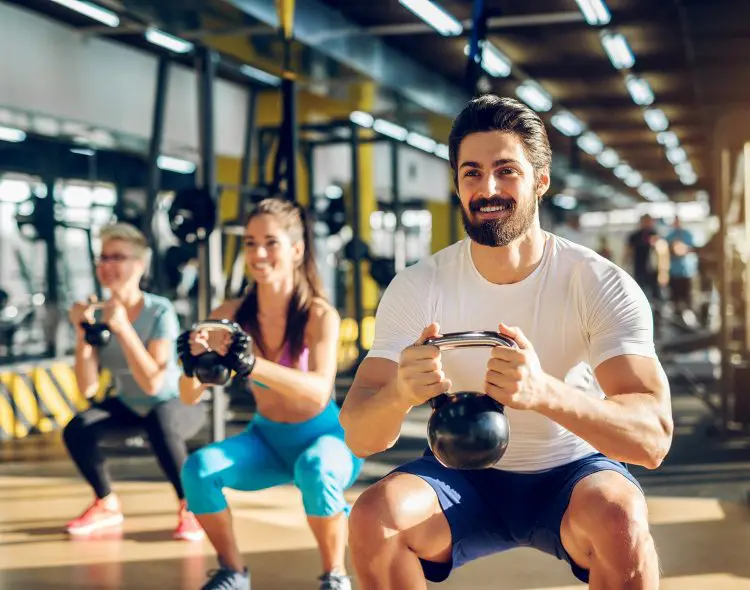
If you want functional strength for sports or the activities of daily living, a Smith machine is probably not your best option.
But what if you don’t really care much about functionality? What if your goal is building bigger muscles? In some cases, lack of balance and stability will bring your set to a premature end, reducing some of the muscle-building effects of your workout.
Using a Smith machine means you can keep more stress on the target muscles and concentrate on lifting and lowering the bar rather than balancing and controlling it. Some studies even show that Smith machine squats produce higher levels of lower body muscle activation than barbell squats (1). It only makes sense that you’ll get similar benefits for other compound exercises.
Smith Machines Cause Overuse Injuries
Another criticism of Smith machine training is that the vertical bars lock you into a very repetitive movement pattern that can lead to injury. Again, this is a fair comment. Doing the exact same movement over and over again CAN lead to overuse injuries and could cause knee, hip, shoulder, elbow, or back pain.
But, while you WILL repeat the same exact movement for the duration of your set, it’s doubtful you’ll repeat that precise movement during your subsequent sets. There will be small changes in your position, which means your joints and muscles work at a slightly different angle.
Also, no-one is suggesting you do every exercise of every workout using a Smith machine. For example, you might do Smith machine squats and then do lunges, leg presses, leg extensions, and leg curls. That’s more than enough movement variety to reduce your risk of overuse injuries.
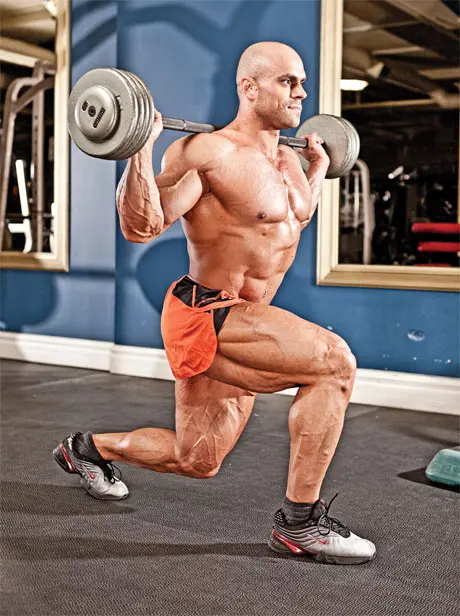
Finally, how is the Smith machine different from any other machine? Unless you are using cables, your limbs are locked into a fixed movement path when you do leg presses, chest presses, shoulder presses, and many other machines. And yet, those machines get none of the hate that is directed at the Smith machine. Leg presses – good, Smith machines – bad: that argument makes no sense!
Training on a Smith machine could actually SAVE you from injury. Just rotate the bar, and it will lock in place. So, if you cannot complete a rep, you can just twist the bar and extricate yourself without injury. Squats, bench presses, and overhead presses are potentially safer when you train with a Smith machine, especially if you take your sets to failure.
Smith Machines are Cheating!
Any time someone does a big bench press or squat using a Smith machine, the shouts of “it’s cheating” are almost deafening! While you cannot compare a Smith machine squat to a barbell squat, this complaint makes no real sense. After all, cheating implies that rules have been broken, but what are the rules for Smith machine squats or bench presses?
Powerlifting has rules, but powerlifters don’t use Smith machines in competition. These calls of cheating are unwarranted unless the lifter in question is suggesting their lift is better than a legitimate barbell lift. They’re two different things – apples and oranges – and cannot really be compared.
Haters are always going to hate, and that’s okay. The Smith machine has been around for over 70 years and is still going strong. Like any tool, the Smith machine has its uses and offers both benefits and drawbacks. Don’t dismiss it out of hand simply because it’s easy or popular to do so. Try it and make up your own mind. You might find that, sometimes, the Smith machine is actually your best option.
Wrapping Up
Some exercisers will go their entire lives without training on a Smith machine. Despite never having used one, they’re convinced that the Smith machine will lead to injury or, at least, turn them into a non-functional, muscle-bound leviathan.
The reality is that when used correctly, this much-maligned piece of gym equipment can be very useful, especially if your goal is hypertrophy. They allow you to train to failure in relative safety and leave you free to focus on lifting and lowering the weight and not balancing or stabilizing it. That might not be “functional,” but sometimes functional is not what’s needed.
So, while some people will never be fans of the Smith machine, it’s important to remember that it’s just another training tool. Use it, or don’t use it; it’s up to you!
References:
1. Journal of Strength and Conditioning Studies: A Comparison of Free Weight Squat to Smith Machine Squat Using Electromyography (source)

